Spatio-Temporal Variability of Soil Water Content under Different Crop Covers in Irrigation Districts of Northwest China
Abstract
:1. Introduction
2. Materials and Methods
2.1. Experimental Site and Design
2.2.1. Statistical Analysis
2.2.2. Entropy
2.2.3. Calculation of Marginal Entropy and Mutual Entropy for Soil Water Content
2.2.4. Informational Correlation Coefficient
3. Results and Discussion
3.1. Temporal Variation of Soil Water Content under Different Crops
3.2. Spatial Variation of Soil Water Content under Different Crops
3.2.1. Soil Water Content Analysis Based on Coefficient of Variation
3.2.2. Soil Water Content Analysis Using Entropy
3.3. Calculation of Mutual Entropy for Influencing Factors of Soil Water Content
4. Conclusions
Acknowledgments
Author Contributions
Conflicts of Interest
References
- Vereecken, H.; Huisman, J.A.; Bogena, H.; Vanderborght, J.; Vrugt, J.A.; Hopmans, J.W. On the value of soil moisture measurements in vadose zone hydrology: A review. Water Resour. Res. 2008, 44, W00D06. [Google Scholar] [CrossRef]
- Gao, X.; Wu, P.; Zhao, X.; Zhang, B.; Wang, J.; Shi, Y. Estimating the spatial means and variability of root-zone soil moisture in gullies using measurements from nearby uplands. J. Hydrol. 2013, 476, 28–41. [Google Scholar] [CrossRef]
- Brocca, L.; Morbidelli, R.; Melone, F.; Moramarco, T. Soil moisture spatial variability in experimental areas of central Italy. J. Hydrol. 2007, 333, 356–373. [Google Scholar] [CrossRef]
- Brocca, L.; Melone, F.; Moramarco, T.; Morbidelli, R. Soil moisture temporal stability over experimental areas in Central Italy. Geoderma 2009, 148, 364–374. [Google Scholar] [CrossRef]
- Wijewardana, Y.G.N.S.; Galagedara, L.W. Estimation of spatio-temporal variability of soil water content in agricultural fields with ground penetrating radar. J. Hydrol. 2010, 391, 24–33. [Google Scholar] [CrossRef]
- Famiglietti, J.S.; Rudnick, J.W.; Rodelli, M. Variability in surface moisture content along a hillslope transect: Rattlesnake Hill, Texas. J. Hydrol. 1998, 210, 259–281. [Google Scholar] [CrossRef]
- Famiglietti, J.; Devereaux, J.; Laymon, C.A.; Tsegaye, T.; Houser, P.R.; Jackson, T.J.; Graham, S.T.; Rodell, M.; van Oevelen, P.J. Ground-based investigation of soil moisture variability within remote sensing footprints during the Southern Great Plains 1997 (SGP 97) Hydrology Experiment. Water Resour. Res. 1999, 35, 1839–1851. [Google Scholar] [CrossRef]
- Penna, D.; Borga, M.; Norbiato, D.; Dalla, F.G. Hillslope scale soil moisture variability in a steep alpine terrain. J. Hydrol. 2009, 364, 311–327. [Google Scholar] [CrossRef]
- Liang, W.L.; Hung, F.X.; Chan, M.C.; Lu, T.H. Spatial structure of surface soil water content in a natural forested headwater catchment with a subtropical monsoon climate. J. Hydrol. 2014, 516, 210–221. [Google Scholar] [CrossRef]
- Brocca, L.; Tullo, T.; Melone, F.; Moramarco, T.; Morbidelli, R. Catchment scale soil moisture spatial-temporal variability. J. Hydrol. 2012, 422, 63–75. [Google Scholar] [CrossRef]
- Joshi, C.; Mohanty, B.P.; Jacobs, J.M.; Ines, A.V. Spatiotemporal analyses of soil moisture from point to footprint scale in two different hydroclimatic regions. Water Resour. Res. 2011, 47, W01508. [Google Scholar] [CrossRef]
- Rosenbaum, U.; Bogena, H.R.; Herbst, M.; Huisman, J.A.; Peterson, T.J.; Weuthen, A. Seasonal and event dynamics of spatial soil moisture patterns at the small catchment scale. Water Resour. Res. 2012, 48, W10544. [Google Scholar] [CrossRef]
- Joshi, C. Understanding Spatio-Temporal Variability and Associated Physical Controls of Near-Surface Soil Moisture in Different Hydro-Climates. Ph.D. Thesis, Texas A&M University, College Station, TX, USA, 2013. [Google Scholar]
- Gómez-Plaza, A.; Mart Nez-Mena, M.; lbaladejo, J.; Castillo, V.M. Factors regulating spatial distribution of soil water content in small semiarid catchments. J. Hydrol. 2001, 253, 211–226. [Google Scholar] [CrossRef]
- Li, H.; Shen, W.; Zou, C.; Jiang, J.; Fu, L.; She, G. Spatio-temporal variability of soil moisture and its effect on vegetation in a desertified aeolian riparian ecotone on the Tibetan Plateau, China. J. Hydrol. 2013, 479, 215–225. [Google Scholar] [CrossRef]
- Baroni, G.; Ortuani, B.; Facchi, A.; Gandolfi, C. The role of vegetation and soil properties on the spatio-temporal variability of the surface soil moisture in a maize-cropped field. J. Hydrol. 2013, 489, 148–159. [Google Scholar] [CrossRef]
- Joshi, C.; Mohanty, B.P. Physical controls of near surface soil moisture across varying spatial scales in an agricultural landscape during SMEX02. Water Resour. Res. 2010, 46, W12503. [Google Scholar] [CrossRef]
- Mohanty, B.P.; Skaggs, T.H. Spatio-temporal evolution and time-stable characteristics of soil moisture within remote sensing footprints with varying soil, slope, and vegetation. Adv. Water Resour. 2001, 24, 1051–1067. [Google Scholar] [CrossRef]
- Zhou, J.; Fu, B.; Gao, G.; Lü, N.; Lü, Y.; Wang, S. Temporal stability of surface soil moisture of different vegetation types in the Loess Plateau of China. CATENA 2015, 128, 1–15. [Google Scholar] [CrossRef]
- Song, X.Y.; Kang, S.Z.; Shen, B. Dynamic Regularity of Soil Moisture in Farmland with Different Planting on Loess Hilly and Gully Region in North-West of China. J. Soil Water Conserv. 2003, 2, 130–133. [Google Scholar]
- Odhiambo, J.J.O.; Bomke, A.A. Cover crop effects on spring soil water content and the implications for cover crop management in south coastal British Columbia. Agric. Water Manag. 2007, 88, 92–98. [Google Scholar] [CrossRef]
- Hu, W.; Si, B.C. Revealing the relative influence of soil and topographic properties on soil water content distribution at the watershed scale in two sites. J. Hydrol. 2014, 516, 107–118. [Google Scholar] [CrossRef]
- Li, T.; Hao, X.M.; Kang, S.Z. Spatiotemporal variability of soil moisture as affected by soil properties during irrigation cycles. Soil Sci. Soc. Am. J. 2014, 598–608. [Google Scholar] [CrossRef]
- Molina, A.J.; Latron, J.; Rubio, C.M.; Gallart, F.; Llorens, P. Spatio-temporal variability of soil water content on the local scale in a Mediterranean mountain area (Vallcebre, North Eastern Spain). How different spatio-temporal scales reflect mean soil water content. J. Hydrol. 2014, 516, 182–192. [Google Scholar] [CrossRef]
- Bogena, H.R.; Herbst, M.; Huisman, J.A.; Rosenbaum, U.; Weuthen, A.; Vereecken, H. Potential of wireless sensor networks for measuring soil water content variability. Vadose Zone J. 2010, 9, 1002–1013. [Google Scholar] [CrossRef]
- Hu, W.; Si, B.C. Soil water prediction based on its scale-specific control using multivariate empirical mode decomposition. Geoderma 2013, 193, 180–188. [Google Scholar] [CrossRef]
- Whalley, W.R.; Binley, A.; Watts, C.W.; Shanahan, P.; Dodd, L.C.; Ober, E.S.; Ashton, R.W.; Webster, C.P.; White, R.P.; Hawkesford, M.J. Methods to estimate changes in soil water for phenotyping root activity in the field. Plant Soil 2017, 415, 407–422. [Google Scholar] [CrossRef]
- Wang, Y.Q.; Shao, M.A.; Liu, Z.P. Vertical distribution and influencing factors of soil water content within 21-m profile on the Chinese Loess Plateau. Geoderma 2013, 193, 300–310. [Google Scholar] [CrossRef]
- Dodd, I.C.; Whalley, W.R.; Obe, R.E.S.; Parry, M.A.J. Genetic and management approaches to boost UK wheat yields by ameliorating water deficits. J. Exp. Bot. 2011, 62, 5241–5248. [Google Scholar] [CrossRef] [PubMed]
- Gaur, N.; Mohanty, B.P. Evolution of physical controls for soil moisture in humid and subhumid watersheds. Water Resour. Res. 2013, 9, 1244–1258. [Google Scholar] [CrossRef]
- Singh, V.P. Entropy theory for movement of moisture in soils. Water Resour. Res. 2010, 46, W03516. [Google Scholar] [CrossRef]
- Kang, S.Z.; Su, X.L.; Tong, L.; Zhang, J.H.; Zhang, L.; Davies, W.J. A warning from an ancient oasis: Intensive human activities are leading to potential ecological and social catastrophe. Int. J. Sustain. Dev. World 2008, 15, 440–447. [Google Scholar] [CrossRef]
- Li, S.; Kang, S.Z.; Zhang, L.; Ortega-Farias, S.; Li, F.; Du, T.; Tong, L.; Wang, S.; Ingman, M.; Guo, W. Measuring and modeling maize evapotranspiration under plastic film-mulching condition. J. Hydrol. 2013, 503, 153–168. [Google Scholar] [CrossRef]
- Warrick, A.W.; Nielsen, D.R. Spatial Variability of Soil Physical Properties in the Field; Academic Press: New York, NY, USA, 1980; pp. 319–344. [Google Scholar]
- Shannon, C.E. A mathematical theory of communication. Bell Syst. Tech. J. 1948, 27, 623–656. [Google Scholar] [CrossRef]
- Shannon, C.E. A mathematical theory of communication. ACM SIGMOBILE Mob. Comput. Commun. Rev. 2001, 5, 3–55. [Google Scholar] [CrossRef]
- Li, C.; Singh, V.P.; Mishra, A.K. Entropy theory-based criterion for hydrometric network evaluation and design: Maximum information minimum redundancy. Water Resour. Res. 2012, 48, W05521. [Google Scholar] [CrossRef]
- Singh, V.P. Entropy Theory and Its Application in Environmental and Water Engineering; Wiley: Hoboken, NJ, USA, 2013. [Google Scholar]
- Singh, V.P. Entropy Theory in Hydrologic Science and Engineering; McGraw-Hill: New York, NY, USA, 2015. [Google Scholar]
- Kang, S.Z.; Gu, B.J.; Du, T.S.; Zhang, J.H. Crop coefficient and ratio of transpiration to evapotranspiration of winter wheat and maize in a semi-humid region. Agric. Water Manag. 2003, 59, 239–254. [Google Scholar] [CrossRef]
- Utset, A.; Farre, I.; Martinez-Cob, A.; Cavero, J. Comparing Penman–Monteith and Priestley–Taylor approaches as reference-evapotranspiration inputs for modeling maize water-use under Mediterranean conditions. Agric. Water Manag. 2004, 66, 205–219. [Google Scholar] [CrossRef]
- Ding, R.S.; Kang, S.Z.; Li, F.S.; Zhang, Y.Q.; Tong, L.; Sun, Q.Y. Evaluating eddy covariance method by large-scale weighing lysimeter in a maize field of north-west China. Agric. Water Manag. 2010, 98, 87–95. [Google Scholar] [CrossRef]
- Ding, R.S. Mechanism of Water and Heat Transfer and Evaportranspitation Modeling over Maize Field in an Arid Inland Region. Ph.D. Thesis, China Agricultrual University, Beijing, China, 2012. [Google Scholar]
- Ding, R.S.; Kang, S.Z.; Li, F.S.; Zhang, Y.Q.; Tong, L. Evapotranspiration measurement and estimation using modified Priestley–Taylor model in an irrigated maize field with mulching. Agric. For. Meteorol. 2013, 168, 140–148. [Google Scholar] [CrossRef]
- Lian, C.Y.; Ma, Z.M.; Lu, X.D.; Cao, S.Y. Research on main crops water requirement and crop Coefficient in Oasis irrigation Region. J. Irrig. Drain. 2012, 31, 136–139. (In Chinese) [Google Scholar]
- Allen, R.G.; Pereira, L.S.; Raes, D.; Smith, M. Crop Evapotranspiration: Guidelines for Computing Crop Water Requirements; Irrigation and Drainage Paper No.56; FAO: Rome, Italy, 1998. [Google Scholar]
- Hausser, J.; Strimmer, K. Entropy inference and the James-Stein estimator, with application to nonlinear gene association networks. J. Mach. Learn. Res. 2009, 10, 1469–1484. [Google Scholar]
- Wang, L. Evaluation of Effectiveness of Soil Moisture in Shiyang River Basin Farmland and Its Dynamic Simulation. Ph.D. Thesis, Northwest A&F University, Xianyang, China, 2014. [Google Scholar]
- Henning, H.; Olga, T.; Heinz-Josef, K.; Bernward, M. Subsoil properties and cereal growth as affected by a single pass of heavy machinery and two tillage systemson a Luvisol. J. Plant Nutr. Soil Sci. 2008, 171, 580–590. [Google Scholar]
- Ryu, D.; Famiglietti, J.S. Multi-scale spatial correlation and scaling behavior of surface soil moisture. Geophys. Res. Lett. 2006, 33, L08404. [Google Scholar] [CrossRef]
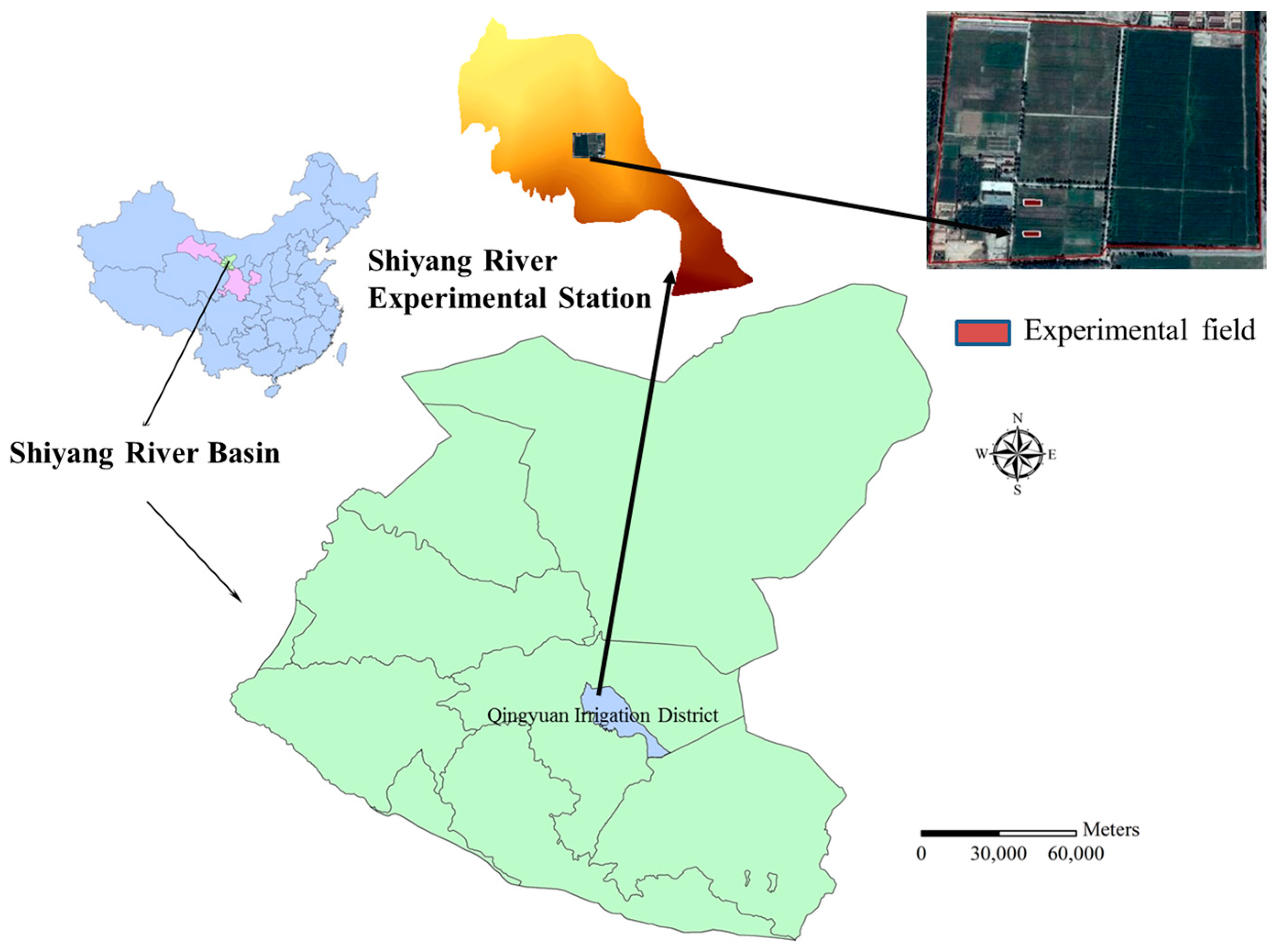
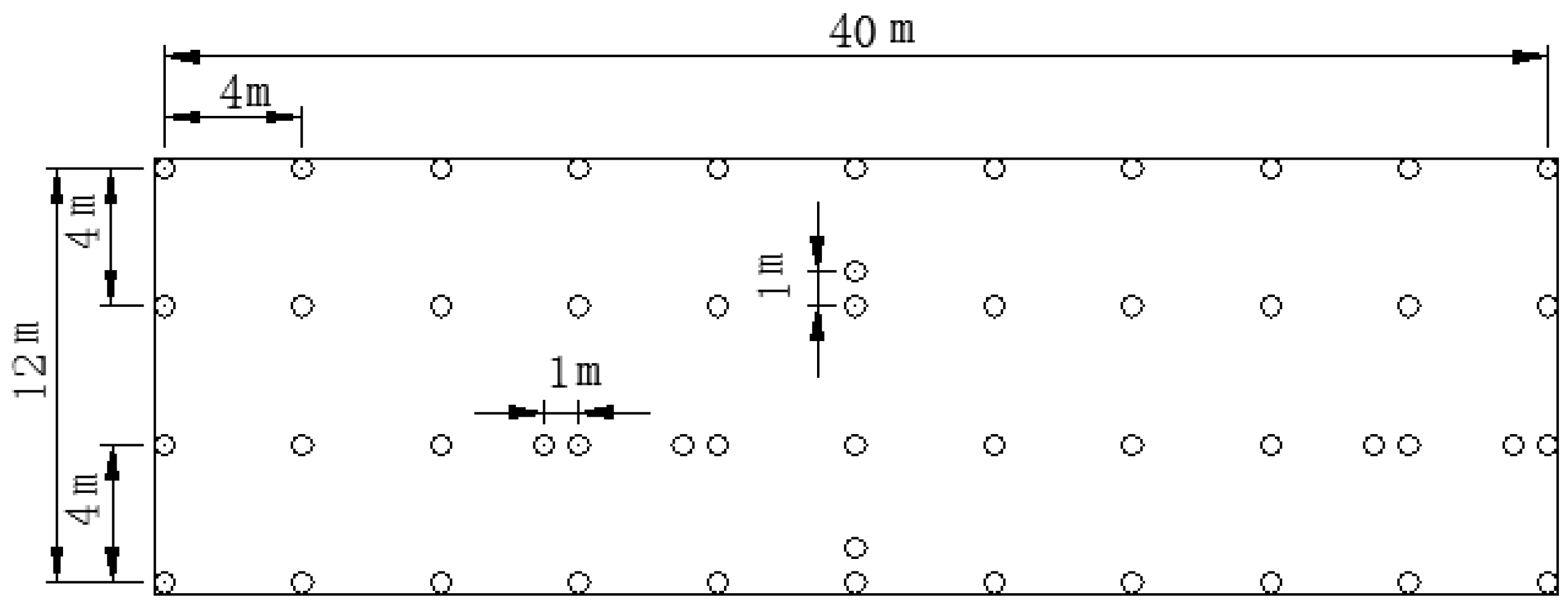
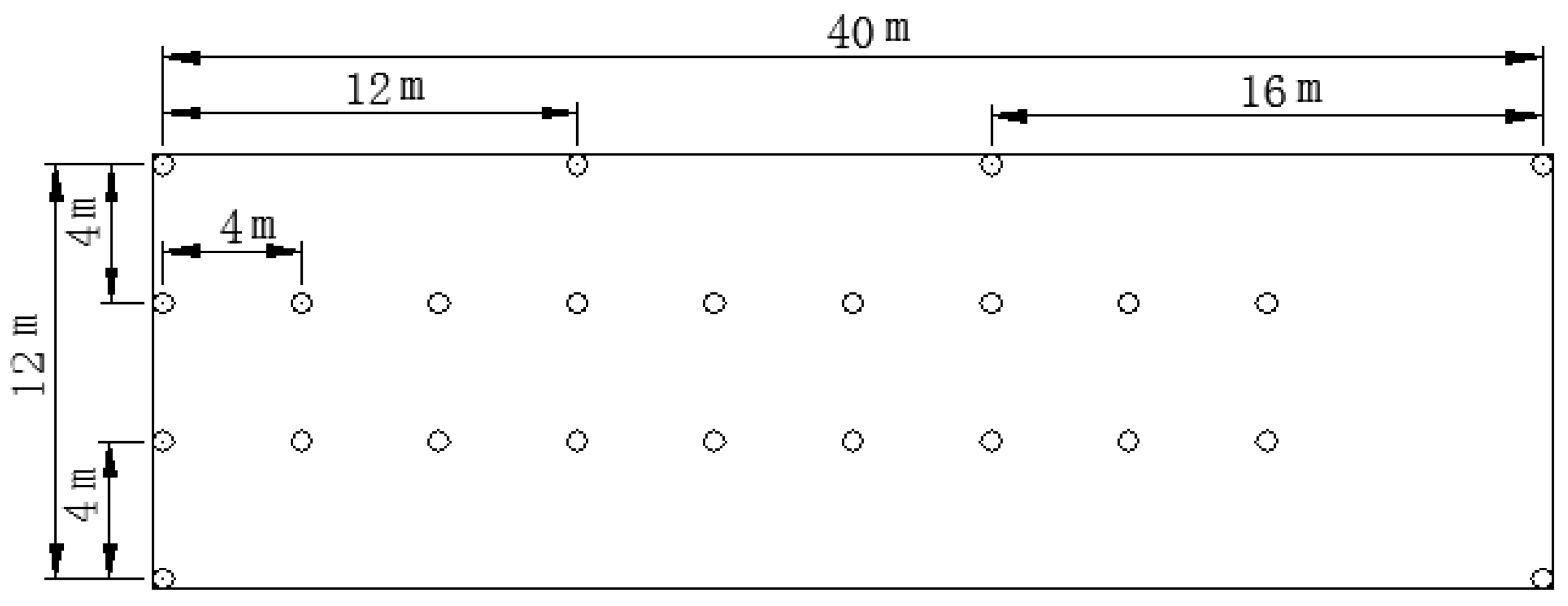
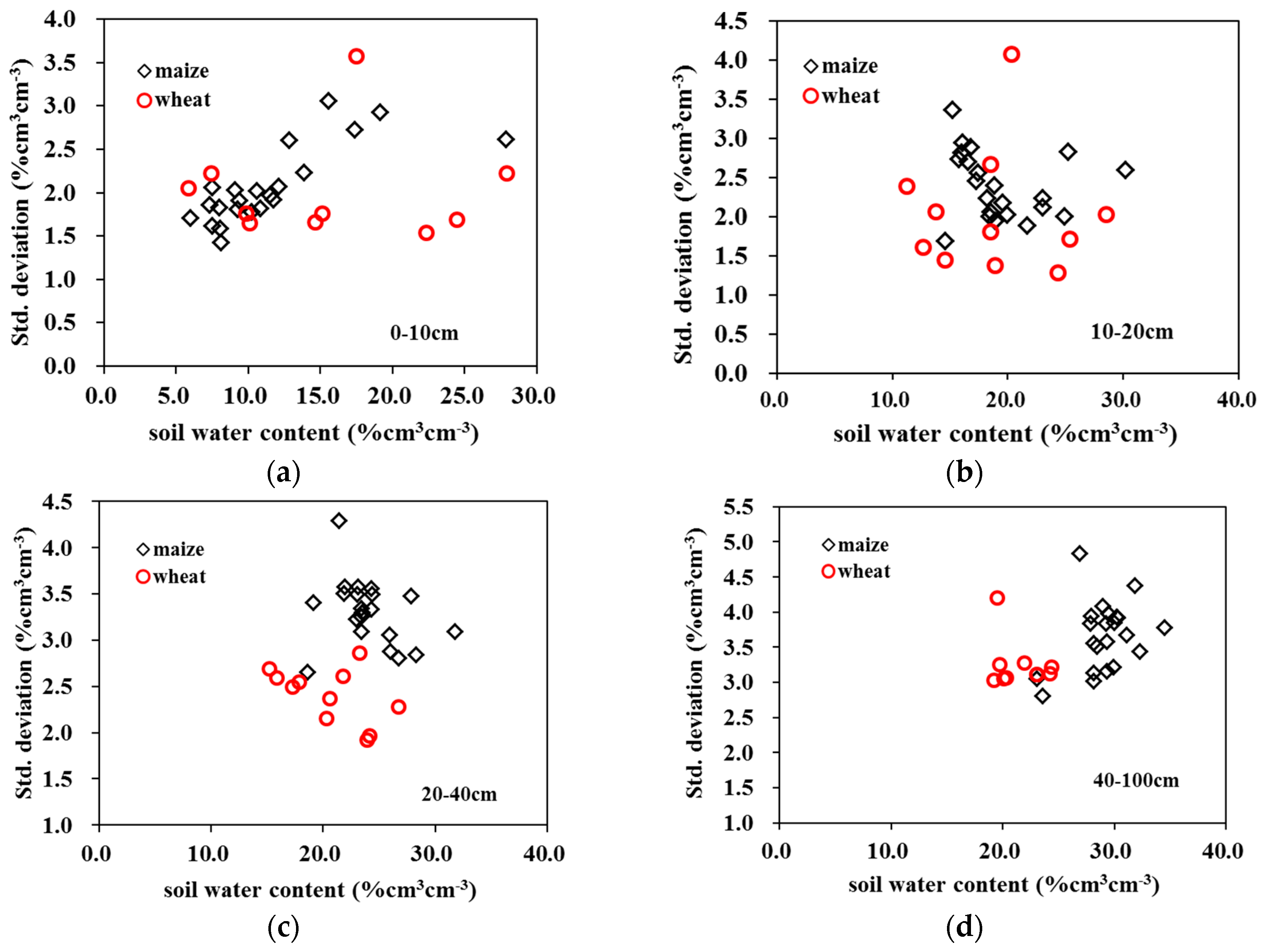
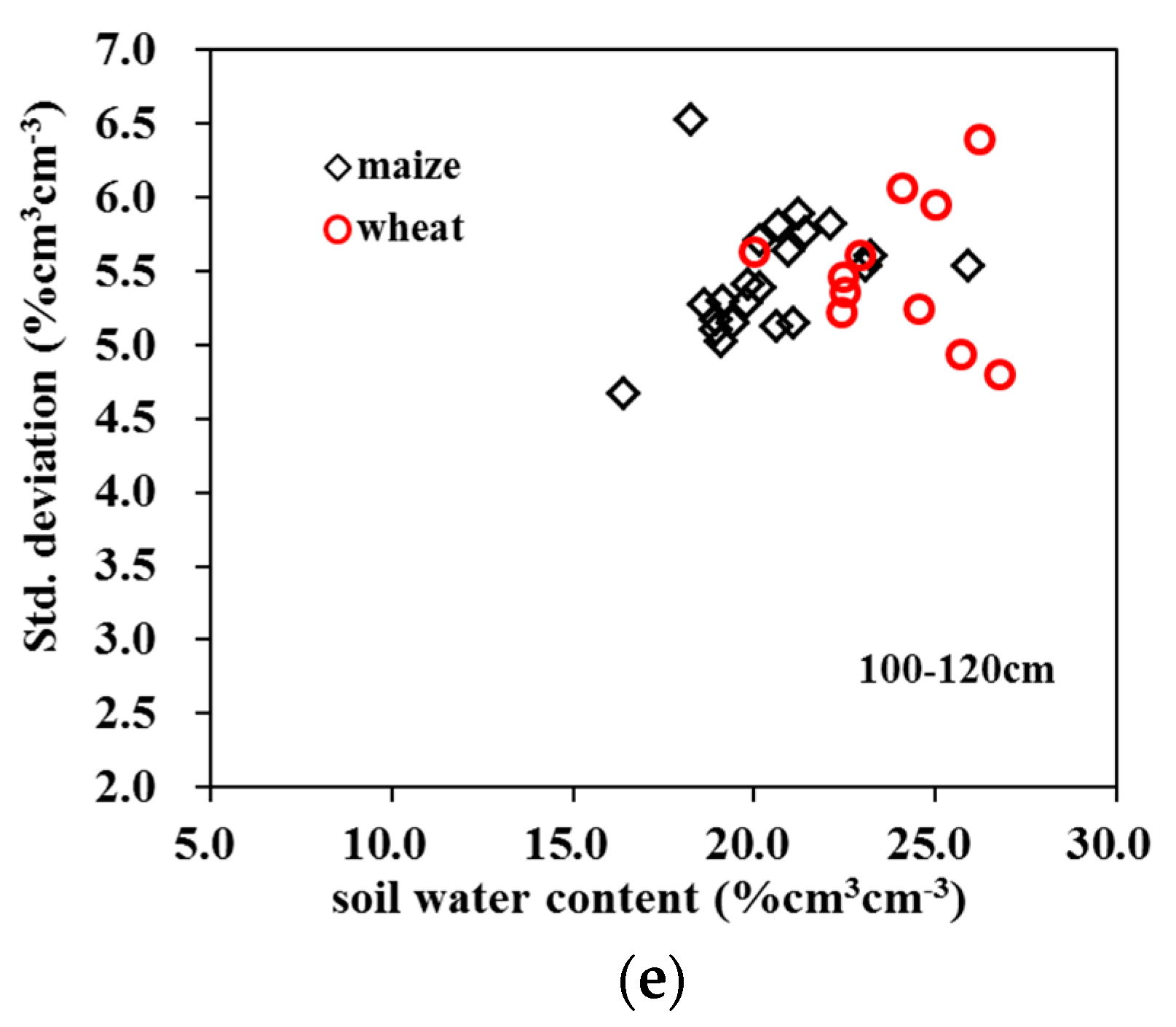
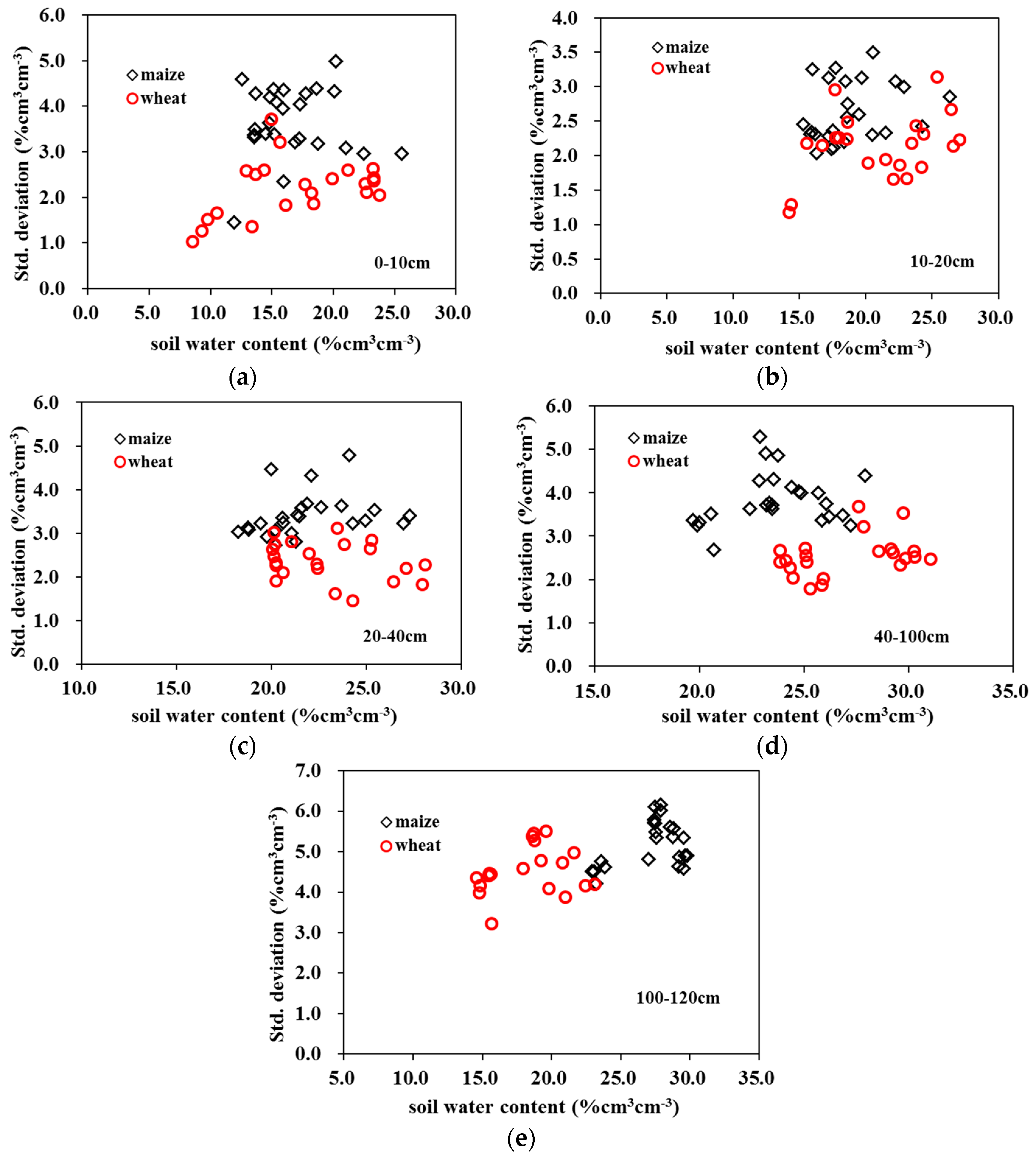

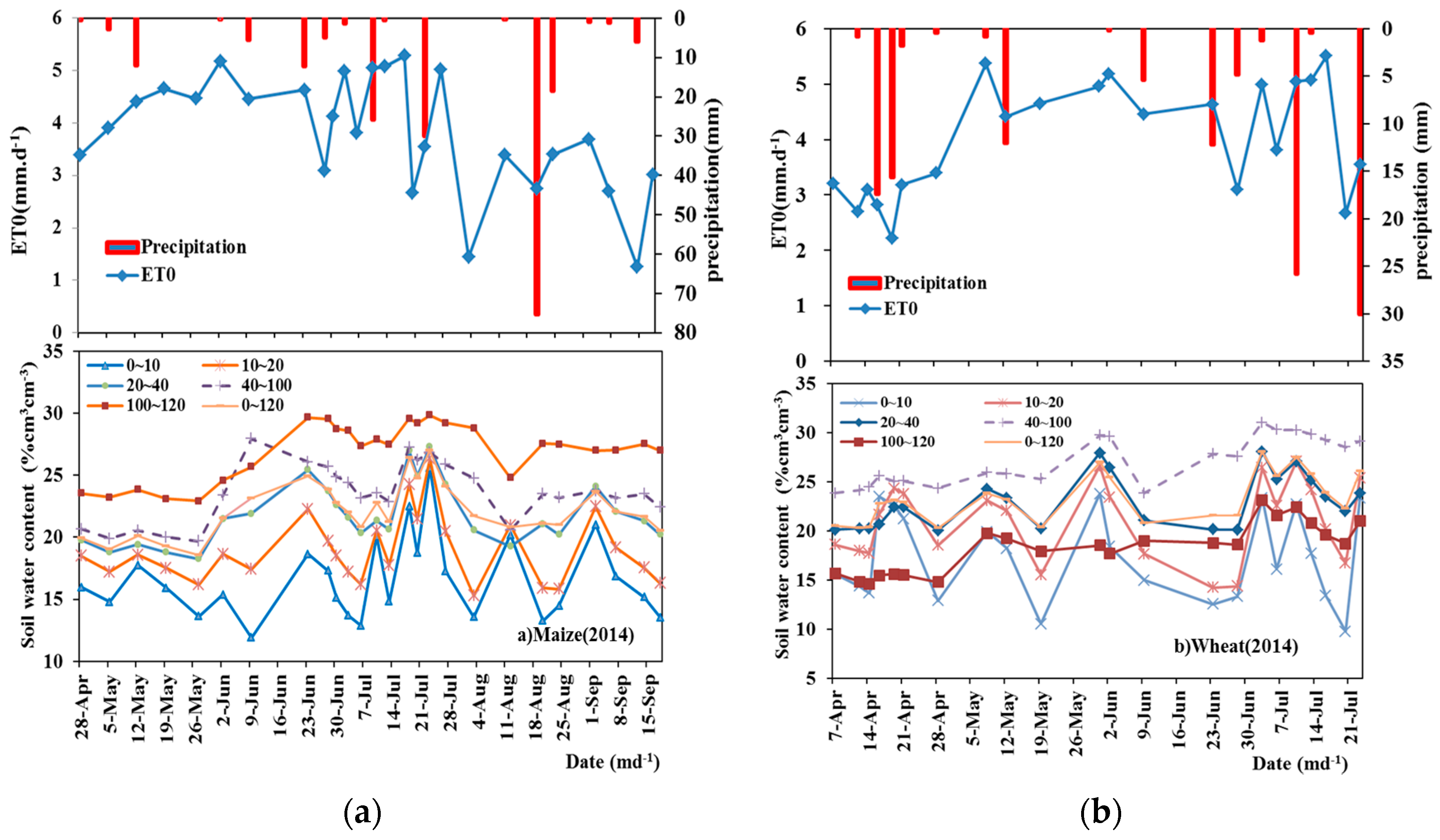
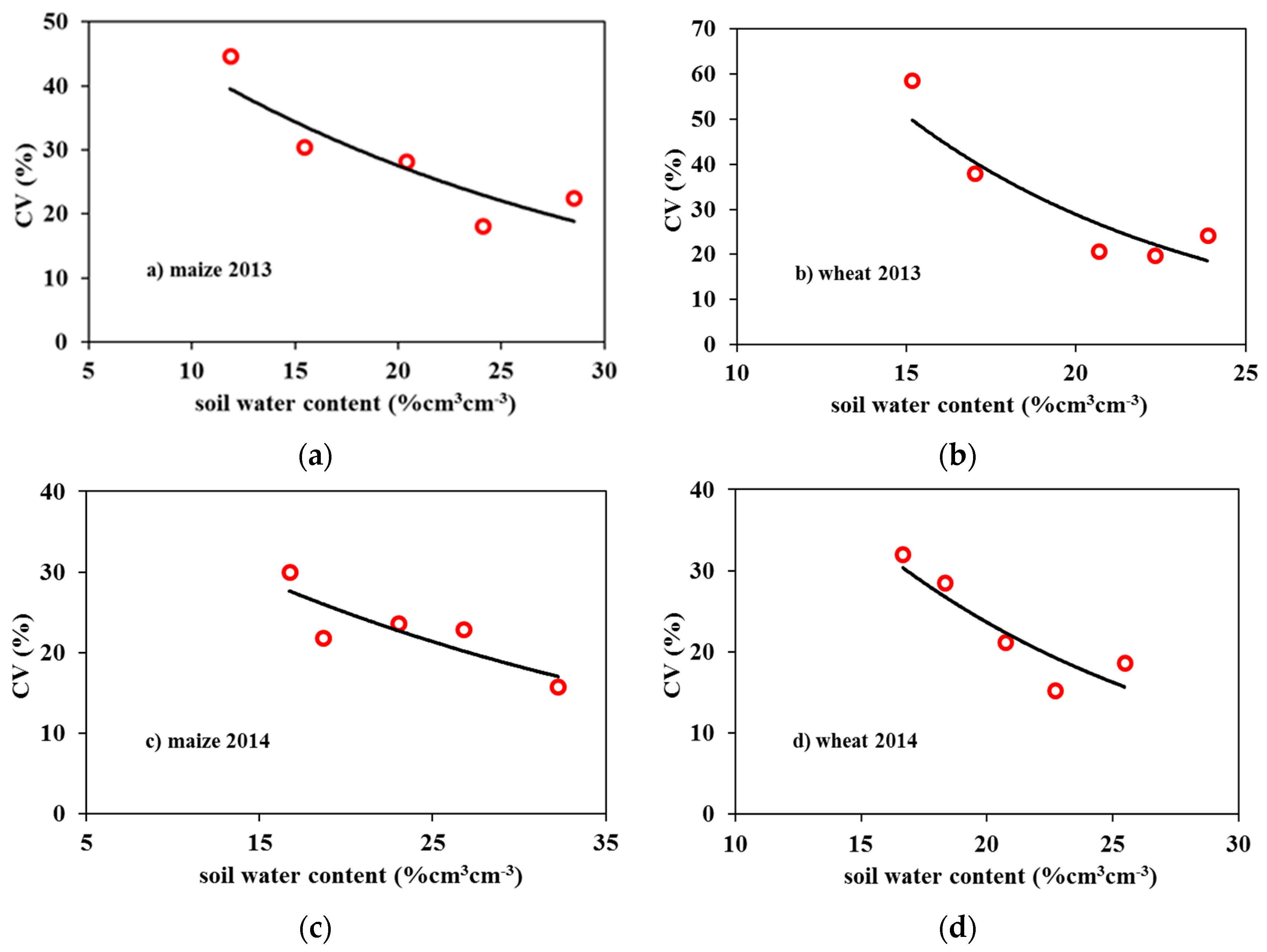

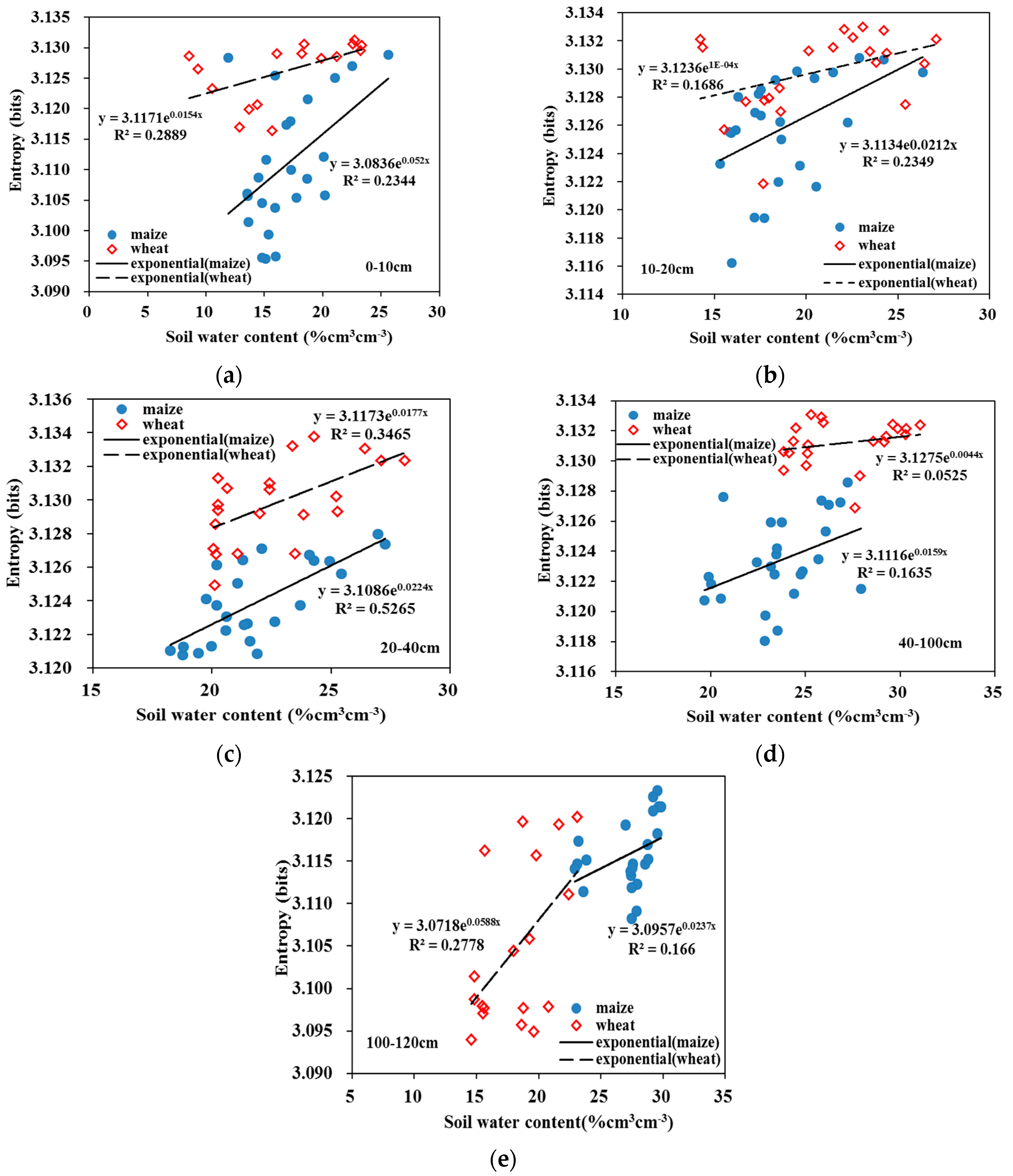
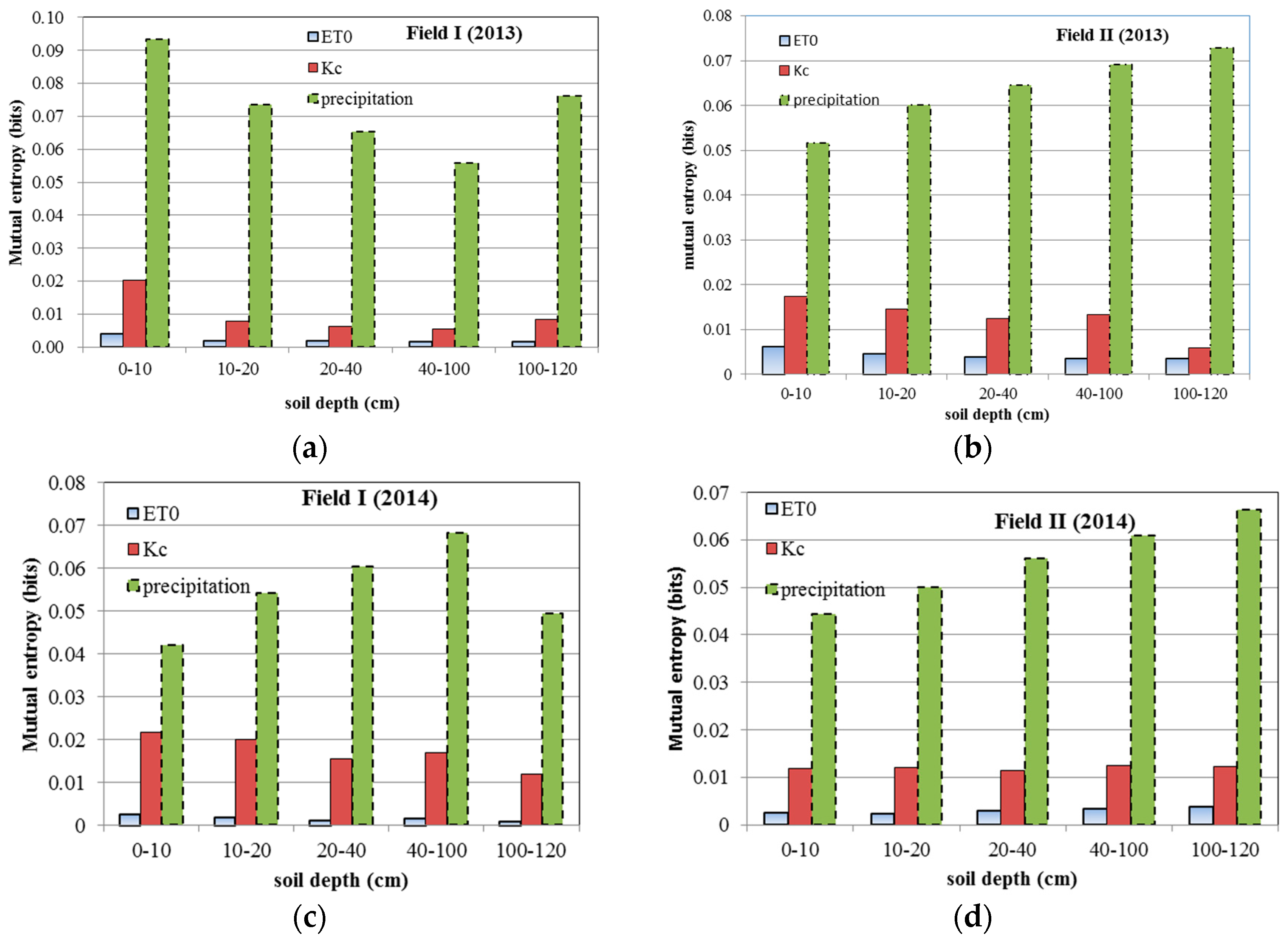
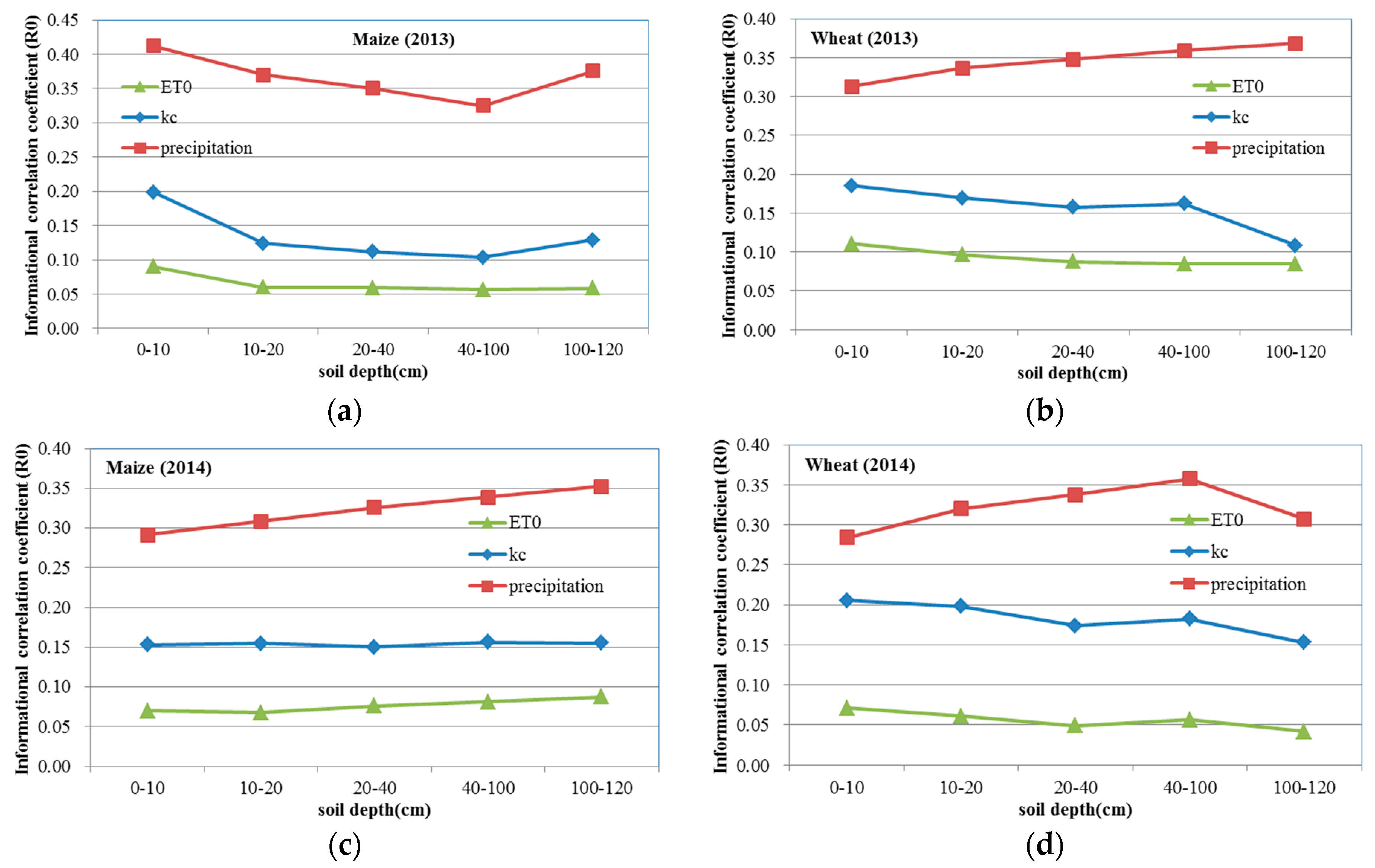
| Field Site | Soil Depth (cm) | Soil Particle Content (g/g) | Soil Type | ||
|---|---|---|---|---|---|
| Sand | Silt | Clay | |||
| I | 10 | 0.629 | 0.268 | 0.103 | sandy loam |
| 20 | 0.649 | 0.251 | 0.0996 | sandy loam | |
| 40 | 0.656 | 0.241 | 0.103 | sandy loam | |
| 60 | 0.443 | 0.412 | 0.146 | loam | |
| 80 | 0.653 | 0.260 | 0.087 | sandy loam | |
| 100 | 0.931 | 0.052 | 0.017 | sandy soil | |
| 120 | 0.616 | 0.301 | 0.083 | sandy loam | |
| II | 10 | 0.620 | 0.271 | 0.109 | sandy loam |
| 20 | 0.663 | 0.243 | 0.095 | sandy loam | |
| 40 | 0.531 | 0.343 | 0.127 | sandy loam | |
| 60 | 0.518 | 0.349 | 0.134 | sandy loam | |
| 80 | 0.482 | 0.401 | 0.117 | loam | |
| 100 | 0.505 | 0.362 | 0.133 | sandy loam | |
| 120 | 0.706 | 0.219 | 0.074 | sandy loam | |
| Depth (cm) | Land Cover | Field Site | Minimum (%cm3cm−3) | Maximum (%cm3cm−3) | Mean (%cm3cm−3) | Std. Deviation (%cm3cm−3) | CV (%) |
|---|---|---|---|---|---|---|---|
| 0–10 | maize | I | 0.62 | 32.19 | 11.86 | 5.30 | 44.65 |
| wheat | II | 2.13 | 32.47 | 15.17 | 7.39 | 58.70 | |
| 10–20 | maize | I | 1.53 | 31.94 | 15.44 | 4.71 | 30.53 |
| wheat | II | 3.29 | 32.73 | 17.01 | 6.46 | 37.98 | |
| 20–40 | maize | I | 3.63 | 36.39 | 24.12 | 4.35 | 18.10 |
| wheat | II | 7.42 | 30.00 | 20.66 | 4.30 | 20.81 | |
| 40–100 | maize | I | 8.65 | 41.84 | 28.52 | 6.41 | 22.49 |
| wheat | II | 12.86 | 34.31 | 22.33 | 4.41 | 19.75 | |
| 100–120 | maize | I | 8.19 | 35.61 | 20.39 | 5.75 | 28.20 |
| wheat | II | 10.48 | 37.89 | 23.88 | 5.81 | 24.33 |
| Depth (cm) | Land Cover | Field Site | Minimum (%cm3cm−3) | Maximum (%cm3cm−3) | Mean (%cm3cm−3) | Std. Deviation (%cm3cm−3) | CV (%) |
|---|---|---|---|---|---|---|---|
| 0–10 | maize | II | 4.76 | 31.59 | 16.74 | 5.03 | 30.05 |
| wheat | I | 6.46 | 29.09 | 16.66 | 5.33 | 31.99 | |
| 10–20 | maize | II | 8.51 | 31.94 | 18.69 | 4.09 | 21.88 |
| wheat | I | 10.09 | 30.81 | 20.74 | 4.40 | 21.22 | |
| 20–40 | maize | II | 5.14 | 36.39 | 32.23 | 5.15 | 15.80 |
| wheat | I | 12.76 | 33.66 | 22.71 | 3.46 | 15.24 | |
| 40–100 | maize | II | 4.46 | 33.16 | 23.04 | 5.45 | 23.66 |
| wheat | I | 13.72 | 35.89 | 25.48 | 4.75 | 18.64 | |
| 100–120 | maize | II | 4.78 | 38.60 | 26.79 | 5.97 | 22.84 |
| wheat | I | 8.37 | 30.90 | 18.33 | 5.22 | 28.48 |
© 2017 by the authors. Licensee MDPI, Basel, Switzerland. This article is an open access article distributed under the terms and conditions of the Creative Commons Attribution (CC BY) license (http://creativecommons.org/licenses/by/4.0/).
Share and Cite
Wang, S.; Singh, V.P. Spatio-Temporal Variability of Soil Water Content under Different Crop Covers in Irrigation Districts of Northwest China. Entropy 2017, 19, 410. https://doi.org/10.3390/e19080410
Wang S, Singh VP. Spatio-Temporal Variability of Soil Water Content under Different Crop Covers in Irrigation Districts of Northwest China. Entropy. 2017; 19(8):410. https://doi.org/10.3390/e19080410
Chicago/Turabian StyleWang, Sufen, and Vijay P. Singh. 2017. "Spatio-Temporal Variability of Soil Water Content under Different Crop Covers in Irrigation Districts of Northwest China" Entropy 19, no. 8: 410. https://doi.org/10.3390/e19080410




